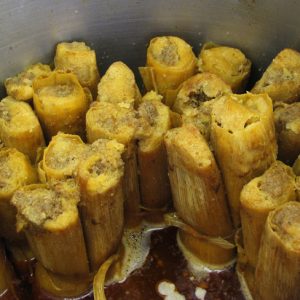calsfoundation@cals.org
Tamales
Tamales are found on restaurant menus and at roadside stands throughout Arkansas and have been a vibrant foodways tradition in the state for generations. This ancient food with roots in Latin America has had a presence in Arkansas and other parts of the American South since at least the early twentieth century. The familiar ingredients (meat and meal) made tamales popular, as did the practicality of being able to take a warm and filling lunch into a cotton field.
There are a handful of hypotheses to help explain how and when tamales crossed the southern border into the United States to become a popular food in the South. Some think there might be a Native American connection. Others opine that the close of the Mexican War saw soldiers returning home with a taste for tamales and a recipe in hand. Many simply believe that tamales have always been here. Most are convinced, though, that they were brought to the area by Latino migrant laborers who worked in cotton fields up and down the Mississippi River in the 1920s and 1930s. But in Arkansas, the history of tamales reaches back even further.
The St. Columbia family in Helena-West Helena (Phillips County) has been making and selling hot tamales since the late nineteenth century. In 1892, Peter St. Columbia arrived in the United States from his native Sicily, landing at the Port of New Orleans. He traveled up the Mississippi River, peddling dry goods to local communities and Hispanic field workers along the river’s banks. Not knowing much English, St. Columbia discovered that the linguistic similarities between Italian and Spanish offered an ease of communication between the two groups, and a tamale recipe was eventually shared. The Hispanic field workers wanted tamales, and St. Columbia had the staple Southern ingredients at hand: cornmeal and beef. He and his son, Pasquale, made and sold tamales together for the next forty or so years. In 1987, grandson Joe St. Columbia revived the family’s recipe and named his business after his father, Pasquale. Today, Pasquale’s Hot Tamales enjoys a thriving Internet-based business.
Tamales are found throughout the state. They have been on the menu at McClard’s Bar-B-Q in Hot Springs (Garland County) since Alex and Gladys McClard opened the restaurant in 1928. Lake Village (Chicot County) became home to Rhoda’s Hot Tamales in the 1980s; Rhoda Adams died in 2023. In 1998, the Mississippi Delta’s rich tamale culture arrived in western Arkansas when Doe’s Eat Place of Greenville, Mississippi, opened a restaurant in Hot Springs.
Arkansas has many makers and vendors of these portable bundles of meat and meal, and there are many versions of tamales made with beef, chicken, and even venison. Some are wrapped the traditional way, in cornhusks, while others are rolled in parchment paper. But even with so many variations, Delta tamales are very different from their Latin American counterparts, the rough texture of cornmeal being the primary signifier of one made in the Delta.
For additional information:
Evans, Amy. Interview with Joe St. Columbia. March 31, 2006. Southern Foodways Alliance. University of Mississippi Archives and Special Collections, Oxford, Mississippi.
Mississippi Delta Hot Tamale Trail. http://www.tamaletrail.com (accessed August 31, 2022).
Van Zandt, Emily. “Still Hot on Tamales.” Arkansas Life (June 2014): 75–77.
Webb, Kane. “On the Tamale Trail.” Arkansas Democrat-Gazette, August 3, 2008, pp. 1J, 3J, 6J.
Amy Evans
Southern Foodways Alliance
 Food and Foodways
Food and Foodways The Bright Spot Interior
The Bright Spot Interior  The Bright Spot
The Bright Spot  Lackey's Hot Tamales
Lackey's Hot Tamales  Rhoda's Tamales
Rhoda's Tamales  Tamales
Tamales 




Shorty’s Tamales in Fort Smith has been business since 1932.